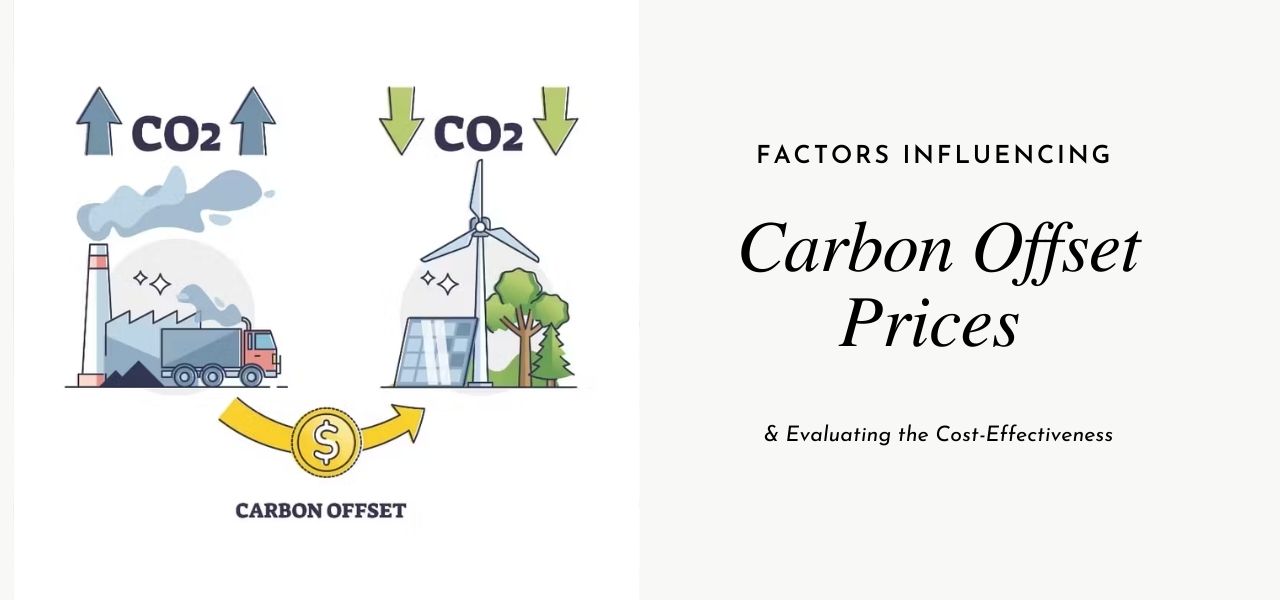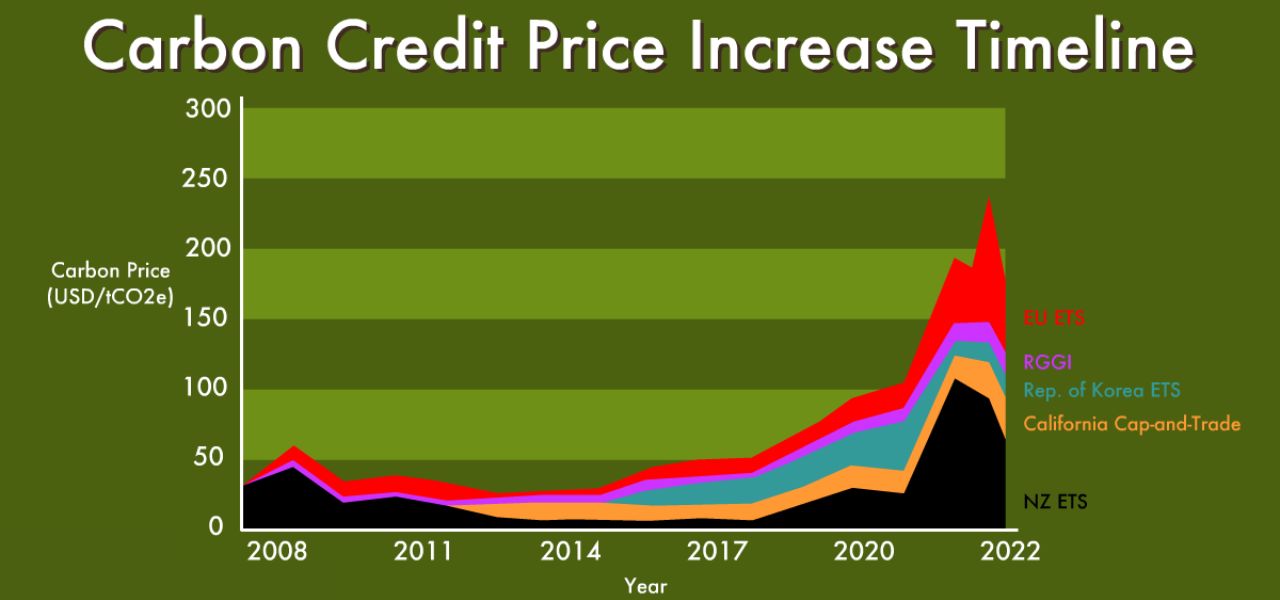Factors Influencing Carbon Offset Prices and Evaluating the Cost-Effectiveness

Carbon offset projects have become increasingly important for organizations seeking to address their carbon footprint. Understanding the factors that influence carbon offset prices is crucial for making informed decisions and evaluating the cost-effectiveness of these initiatives.
In this article, we will explore key considerations such as carbon offset price per ton, comparing costs with internal emission reduction measures, and the importance of assessing co-benefits and long-term cost projections. By delving into these factors, businesses can navigate the complex landscape of carbon offset prices and optimize their sustainability strategies.
Introduction
Carbon offsets are credits or certificates representing a reduction or removal of one metric ton of carbon dioxide equivalent (CO2e) emissions. These credits are generated through various projects, such as renewable energy installations, reforestation efforts, or methane capture initiatives. By supporting these projects, individuals and businesses can effectively counterbalance their own carbon emissions and contribute to the transition to a low-carbon economy.
The carbon market is a complex and dynamic system where carbon offsets are bought and sold. It provides a platform for businesses to invest in emission reduction projects and contribute to global climate goals. However, with the growing popularity of carbon offsets, it becomes crucial to evaluate the cost of these investments.
Evaluating carbon offsets prices helps businesses and individuals make informed decisions about their climate mitigation strategies. With carbon offset price is the monetary value associated with each ton of carbon dioxide equivalent offset. By assessing carbon offsets prices businesses can determine the value they are receiving for their investment in carbon offsets and ensure they are achieving their sustainability objectives efficiently.

Furthermore, evaluating carbon offset prices allows businesses to assess the environmental impact of their offset projects. It helps determine the extent to which carbon emissions are being reduced or sequestered, and whether the chosen projects align with sustainability goals and contribute to long-term climate resilience.
Factors Influencing Carbon Offset Prices
Carbon offset prices are influenced by a variety of factors that shape the dynamics of the carbon market. Understanding these factors is crucial for businesses and individuals looking to engage in carbon offsetting initiatives. This section will explore the key factors that influence carbon offset prices and highlight their significance in determining the cost of offsetting emissions.
Market Demand and Supply Dynamics: The basic principles of supply and demand play a significant role in determining carbon offset prices. If the demand for carbon offsets is high relative to the available supply, prices are likely to increase. Factors such as global emission reduction targets, corporate sustainability goals, and government regulations can impact the demand for carbon offsets.
Project Type and Location: The type of carbon offset project and its geographical location can influence carbon offset prices. Different project types, such as renewable energy projects, forestry projects, or methane capture projects, have varying costs associated with implementation and monitoring. Additionally, the location of the project can affect the level of environmental benefits and the associated costs.
Certification Standards and Quality Assurance: Carbon offset projects must adhere to recognized certification standards to ensure their credibility and effectiveness in reducing emissions. Certification bodies evaluate the project's methodologies, additionality, and emissions reductions, among other criteria. Projects with robust certification standards and rigorous quality assurance processes may command higher carbon offset prices.
Additionality and Credibility of Carbon Offset Projects: Additionality refers to the notion that carbon offset projects should result in emissions reductions that would not have occurred without the project's implementation. Projects with high additionality demonstrate a more significant impact on emissions reduction, which can influence carbon offset price. Credibility, transparency, and the use of internationally recognized methodologies also contribute to the perceived value of carbon offsets.
Policy and Regulatory Landscape: Government policies and regulations play a crucial role in shaping the carbon market and can influence carbon offset prices. Policies such as carbon pricing mechanisms, emission reduction targets, and regulatory frameworks can impact the demand for carbon offsets and create market incentives.

Understanding these factors can help businesses and individuals navigate the carbon offset market and make informed decisions about their carbon mitigation strategies. By considering market dynamics, project characteristics, certification standards, additionality, and policy landscapes, stakeholders can better assess carbon offset price and choose the most suitable options to meet their sustainability goals.
Evaluating the Cost-Effectiveness of Carbon Offsets
When it comes to implementing carbon offset projects, it is essential for businesses and organizations to assess the carbon offset price of these initiatives to evaluate cost-effectiveness. Evaluating the cost-effectiveness not only helps in making informed decisions but also ensures that the investments made in carbon offsets deliver meaningful results in terms of emission reduction and sustainability. Here are some key considerations when evaluating the cost-effectiveness of carbon offsets:
Cost per ton of carbon dioxide equivalent (CO2e): One of the primary factors to evaluate is the cost per ton of CO2e mitigated through the carbon offset project. This metric provides an understanding of the financial investment required to achieve emission reductions. By comparing the cost per ton of CO2e across different offset options, businesses can determine the most cost-effective approach to carbon offset price.
Comparison with internal emission reduction measures: Assessing the cost-effectiveness of carbon offsets involves comparing them with internal emission reduction measures. This analysis helps determine whether investing in offset projects is more economically viable than implementing in-house emission reduction strategies. It allows businesses to identify the most efficient approach to carbon offset price based on their specific circumstances.
Consideration of co-benefits and sustainability outcomes: Cost-effectiveness evaluations should not solely focus on financial aspects. It is important to consider the co-benefits and sustainability outcomes associated with carbon offset projects. These may include biodiversity conservation, community development, and ecosystem restoration. By factoring in these additional benefits, businesses can assess the overall value and impact of the offset initiatives.
Long-term cost projections and risk assessment: Evaluating the cost-effectiveness of carbon offsets requires considering long-term cost projections and potential risks. It is crucial to assess the stability of the carbon offset market and anticipate future changes in offset prices. Additionally, businesses should conduct a comprehensive risk assessment to identify any potential challenges or uncertainties that may impact the carbon offset prices.
By carefully evaluating the cost-effectiveness of carbon offsets, businesses can make informed decisions regarding their carbon mitigation strategies. This analysis helps ensure that investments are directed towards initiatives that deliver significant emission reductions, align with sustainability goals, and provide tangible benefits to the environment and society.
>>> Learn more: Blue Carbon Credits - Preserving Our Ocean's Health
Contact us
AirX is the world's first carbon-negative bio-material made from coffee grounds manufacturer.
We specialize in producing bio-based composites using recycled carbohydrates derived from by-products such as coffee grounds, coconut husk, husk, and bamboo. Our goal is to promote sustainability through the use of eco-friendly materials.
We are always here to help and provide the best service possible. If you have any questions or would like to receive advice and feedback directly from our sales staff, please do not hesitate to contact us. You can reach us through:
- Whatsapp: +84 969 742 950
- Email: [email protected]
We look forward to hearing from you!

